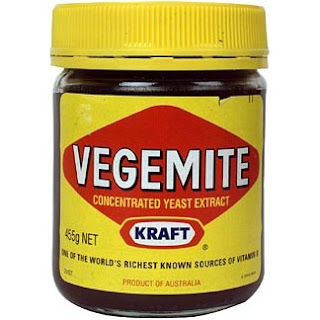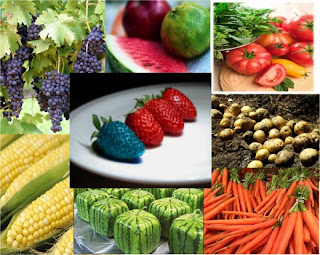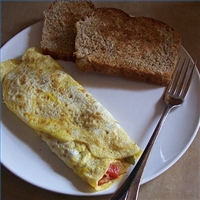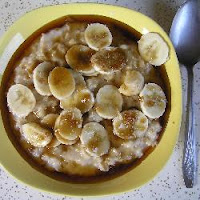G3 Restaurant
Select the following dietry requirements which best describe you.
Wednesday, October 27, 2010
Tuesday, October 12, 2010
Top ten cancer fighting food
The incidence of cancer in Australia has reached alarming proportions and it's easy to feel powerless in the face of the frightening statistics. However, the latest research is showing convincingly that particular foodsmay significantly reduce the risk of cancer in healthy individuals and slow its progress in those already suffering from the disease. By knowing what these cancer-fighting foods are, we can take positive steps in the fight against cancer.
1. Peppers and spices
Capsaicin, which is the main ingredient in hot chillies has been found to be able to kill cancer cells. The ingredient stops oxygen from travelling to cancer cells, which damages cell membranes.
Capsaicin, which is the main ingredient in hot chillies has been found to be able to kill cancer cells. The ingredient stops oxygen from travelling to cancer cells, which damages cell membranes.
2. Green tea
All tea contains antioxidants called catechins, with green tea containing the highest amount. Catechins halt tumour cells and protect healthy cells from damage. A coffee sized mug of tea should provide you with enough.
All tea contains antioxidants called catechins, with green tea containing the highest amount. Catechins halt tumour cells and protect healthy cells from damage. A coffee sized mug of tea should provide you with enough.
3. High fibre foods
Foods that are high in fibre like grains, cereals and apples are broken down in the large intestine or the colon and work to protect it against cancer.
Foods that are high in fibre like grains, cereals and apples are broken down in the large intestine or the colon and work to protect it against cancer.
4. Olive oil
Olive oil is rich in antioxidants and vitamin E and is one of the healthiest fats. Studies have found that olive oil can be helpful in preventing breast and colon cancer.
Olive oil is rich in antioxidants and vitamin E and is one of the healthiest fats. Studies have found that olive oil can be helpful in preventing breast and colon cancer.
5. Tomatoes
Tomatoes are another food high in antioxidants, which protect the body's cells from damage. Adding tomatoes to cooking, such as pasta sauces, is a good way of fighting cancers through food.
Tomatoes are another food high in antioxidants, which protect the body's cells from damage. Adding tomatoes to cooking, such as pasta sauces, is a good way of fighting cancers through food.
6. Garlic
Garlic has a number of therapeutic benefits and apart from boosting immunity. It has been linked to lowering blood cholesterol and confer protection against cancer development and progression.
Garlic has a number of therapeutic benefits and apart from boosting immunity. It has been linked to lowering blood cholesterol and confer protection against cancer development and progression.
7. Green and yellow vegetables
Cruciferous vegetables including Broccoli, cabbage, cauliflower, and Brussels sprouts are all known cancer fighters. They're rich in phytochemicals which provide the body with essential nutrients.
Cruciferous vegetables including Broccoli, cabbage, cauliflower, and Brussels sprouts are all known cancer fighters. They're rich in phytochemicals which provide the body with essential nutrients.
8. Oranges
Being so rich in vitamin c is what makes oranges such a great cancer fighting food. Oranges and orange juice are said to be able to reduce oxidative stress and improve blood levels of HDL cholesterol.
Being so rich in vitamin c is what makes oranges such a great cancer fighting food. Oranges and orange juice are said to be able to reduce oxidative stress and improve blood levels of HDL cholesterol.
9. BeansResearch has show that beans protect against prostate cancer, while soya beans have also shown to have breast cancer-fighting properties.
10. Berries
Berries have been found to contain ellagic acid, which is an antioxidant found in numerous fruits and vegetables. This is the source behind its protective effects against oesophageal and colon cancer.
Berries have been found to contain ellagic acid, which is an antioxidant found in numerous fruits and vegetables. This is the source behind its protective effects against oesophageal and colon cancer.
However, simply eating strawberries, raspberries and blueberries don't work against cancer on their own. A diet high in all fruits will be most effective.
Saturday, October 9, 2010
Traditional Australian Cuisine?
http://www.trespassmag.com/rites-of-passage-eating-vegemite-in-australia/
Most of us can associate different countries with specific types of food without really thinking about it, Italy and pasta, China and noodles, Japan and sushi, Mexico and tacos, USA and 'take-out', but living in Australia, it can be hard to describe a 'traditional food', we can however look at what has shaped our kitchens into what they are today.
Australia's cuisine was first strongly influenced by the English who brought their own traditions to Australia when they settled. It was then later influenced strongly by Asian and Mediterranean cuisines when immigration began to increase.
Today you can find most foods from around the globe in any Australian supermarket. You can find ingredients typical in Asian foods, European foods, American foods as well as popular foods and brands from neighbouring islands in the Pacific.
Globalisation is changing the way we eat and the way we look at foods. Australian's tend to eat a variety of foods for breakfast lunch and dinner, and no particular meal sticks out as the 'most important'. Different families have their own traditions which seem to stem from their own personal heritage.
While the 'barbie' (a barbeque) is an iconic Australian summer tradition, it is also popular in many other countries. Even Vegemite which was traditionally Australian owned and made is now owned by Kraft (which was bought by America some years ago- and ironically- the sale of Vegemite is actually illegal in some American states because of the high level of sodium).
In saying this, Australia has claimed certain foods as its own (to an extent) over our short but rich history as a nation. Think pavlova's, meat pies, fish and chips (at the beach of course), Anzac biscuits, Christmas barbeque lunches, and yes- Vegemite- you will always be seen as Australian!
(And to the Australian's who have spent time overseas- you know how rare it is to see things like Milo, Freddo Frogs, Caramello Koalas, Eucalyptus drops (the real ones), Tim Tams, Jaffas, Pollywaffles and Burger Rings) I guess we don't always realise how Australian some of these products are.
(And to the Australian's who have spent time overseas- you know how rare it is to see things like Milo, Freddo Frogs, Caramello Koalas, Eucalyptus drops (the real ones), Tim Tams, Jaffas, Pollywaffles and Burger Rings) I guess we don't always realise how Australian some of these products are.
Wednesday, October 6, 2010
The Hunger Site
Today, we will take a parallel route from food in today’s society, to the significant issue of food and poverty. In Australia, we are extremely fortunate to have access to the foods present within society. However this is not necessarily the case around the world. Poverty is a fundamentally important issue within countries around the world.
One of the most saddening facts is that children are often the ones that experience food shortages in poverty stricken countries. It has been estimated that daily hunger is an issue for 1/6th of the world population.
There are a number of initiatives to increase the quality of life for these people. However I believe that the political root causes of hunger need to be rectified to benefit those affected. However there are a number of initiatives which assist in this area. An example is http://www.thehungersite.com/, where you can click to help feed the hungry (doesn't cost individual's anything!).
Most importantly, please think of those less fortunate before wasting the wonderful food we have today!
Tuesday, October 5, 2010
Catering for 'fussy eaters'
With so many people now who call themselves vegetarians, vegans, coeliacs, have religious food preferences, or just don't like particular foods for whatever reason, it can be very hard when catering for anyone little own large groups. The most important thing to do when trying to organise food for groups is to find out if anyone has specific dietary requirements, and if so what they are.
Finding out dietary requirements can prove quite a challenge if you're not quite sure what exactly all these words mean. Defining them is actually not a very easy thing to do as some people are vegetarian only some of the time or call themselves vegetarian but will eat white meat. Typically however, a vegetarian is someone who does not eat meat. A vegan on the other hand is someone who does not eat any animal products (meat, eggs, cheese, milk, animal based oils etc). Coeliacs are people who suffer from coeliac disease which prevents them eating products which contain gluten. Religious restrictions are a little different in that they can be imposed only seasonally, or even just during a particular time of the day. They may vary from vegetarianism to veganism, or a ban of food all together (fasting).
There are other less common dietary requirements which I will not mention, but it is important to keep in mind that some people do have other requirements, such as the increasingly common allergy to peanuts and strawberries. These restrictions do NOT make it impossible to feed large groups of people however, with a little planning and creativity you can provide enough food for everyone- even when it seems 'they can't eat anything!!'
If you're just organising a small dinner, then it is possibly easiest to ask anyone who has requirements what sort of foods they eat, and prepare something they suggest, or ask them to bring their own food. If catering for a larger group, it is more than likely that you will have to cater for a few different groups. Try asking them for suggestions, or just try google!
It may sound too simple, but typing a few of these into google can give you some really helpful websites and literally thousands of ideas and recipes to cater for anyone!!
Here are a few of the most helpful ones I have come across:
http://www.peta.org/living/vegetarian-living/default.aspx
http://www.suite101.com/content/cooking-for-vegetarians-a32476
http://www.ehow.com/how_2057428_cook-vegan.html
http://www.coeliachelp.me.uk/Whatcanieat.html
A very handy site if you're unsure about various religious restrictions:
http://www.betterhealth.vic.gov.au/bhcv2/bhcarticles.nsf/pages/Food_culture_and_religion?OpenDocument
Finding out dietary requirements can prove quite a challenge if you're not quite sure what exactly all these words mean. Defining them is actually not a very easy thing to do as some people are vegetarian only some of the time or call themselves vegetarian but will eat white meat. Typically however, a vegetarian is someone who does not eat meat. A vegan on the other hand is someone who does not eat any animal products (meat, eggs, cheese, milk, animal based oils etc). Coeliacs are people who suffer from coeliac disease which prevents them eating products which contain gluten. Religious restrictions are a little different in that they can be imposed only seasonally, or even just during a particular time of the day. They may vary from vegetarianism to veganism, or a ban of food all together (fasting).
There are other less common dietary requirements which I will not mention, but it is important to keep in mind that some people do have other requirements, such as the increasingly common allergy to peanuts and strawberries. These restrictions do NOT make it impossible to feed large groups of people however, with a little planning and creativity you can provide enough food for everyone- even when it seems 'they can't eat anything!!'
If you're just organising a small dinner, then it is possibly easiest to ask anyone who has requirements what sort of foods they eat, and prepare something they suggest, or ask them to bring their own food. If catering for a larger group, it is more than likely that you will have to cater for a few different groups. Try asking them for suggestions, or just try google!
It may sound too simple, but typing a few of these into google can give you some really helpful websites and literally thousands of ideas and recipes to cater for anyone!!
Here are a few of the most helpful ones I have come across:
http://www.peta.org/living/vegetarian-living/default.aspx
http://www.suite101.com/content/cooking-for-vegetarians-a32476
http://www.ehow.com/how_2057428_cook-vegan.html
http://www.coeliachelp.me.uk/Whatcanieat.html
A very handy site if you're unsure about various religious restrictions:
http://www.betterhealth.vic.gov.au/bhcv2/bhcarticles.nsf/pages/Food_culture_and_religion?OpenDocument
Labels:
Dietary Requirements,
Religion,
Vegan,
Vegetarian
Monday, October 4, 2010
The GM food
A variety of foods can be genetically modified using biotechnology – these are known as GM foods.
http://www.geneticallymodifiedfoods.weebly.com/
The GM foods were first put on the market in the early 1990s. Typically, genetically modified foods are transgenic plant products: soybean, corn, canola, and cotton seed oil. Animal products have also been developed, although as of July 2010 none are currently on the market.
Scientists create genetically modified food because there is a need to produce inexpensive, safe and nutritious foods to help feed the world’s growing population. The advantages of GM food have been showed:
In conclusion, the potential benefits, risks and ethical concerns regarding GM foods are still being researched and debated. It does not have to be worried too much since GM foods sold in Australia, or foods containing GM ingredients, are all required by law to be labelled.
http://www.geneticallymodifiedfoods.weebly.com/
The GM foods were first put on the market in the early 1990s. Typically, genetically modified foods are transgenic plant products: soybean, corn, canola, and cotton seed oil. Animal products have also been developed, although as of July 2010 none are currently on the market.
Scientists create genetically modified food because there is a need to produce inexpensive, safe and nutritious foods to help feed the world’s growing population. The advantages of GM food have been showed:
- Sturdy plants able to withstand weather extremes
- Better quality food crops
- Higher nutritional yields in crops
- Inexpensive and nutritious food, like carrots with more antioxidants
- Foods with a greater shelf life, like tomatoes that taste better and last longer
In conclusion, the potential benefits, risks and ethical concerns regarding GM foods are still being researched and debated. It does not have to be worried too much since GM foods sold in Australia, or foods containing GM ingredients, are all required by law to be labelled.
Saturday, October 2, 2010
Simple and healthy breakfast ideas
Breakfast is considered as the most important meal of the day, it breaks the overnight fasting period,replenishes needs of glucose and provides other essential nutrients to keep people's energy level up throughout the day.
It is very unhealthy to skip the breakfast, especially for students and office workers who have a lot of mental work to do. The common reasons for skipping breakfast include not enough time, tired to bother and spend the extra time dozing in bed. This blog post will show some simple and healthy ways to nourish your mind at the start of the day.
1.Fruit smoothie
Chocolate Pear smoothie
2. Avocado and tomato on toast
3. Omelette with vegetables
4. Porridge
5.Muesli
It is very unhealthy to skip the breakfast, especially for students and office workers who have a lot of mental work to do. The common reasons for skipping breakfast include not enough time, tired to bother and spend the extra time dozing in bed. This blog post will show some simple and healthy ways to nourish your mind at the start of the day.
1.Fruit smoothie
Chocolate Pear smoothie
- 1 – 2 pears, chopped up
- 2 tablespoons of cocoa powder
- 1 cup of milk
- 1/4 cup of blueberries
- 1 banana
- 1 pear
- 1 cup of milk
2. Avocado and tomato on toast
- 2 slices bread
- 1 small avocado
- 1/4 teaspoon lime juice
- 1 pinch salt
- 6 cherry tomatoes halved
3. Omelette with vegetables
- eggs
- red peppers
- green peppers
- onion
- mushrooms
- cheese
- ham
4. Porridge
- 3 cups rolled oats
- 1/4 teaspoon salt
- cream, milk or buttermilk
- brown sugar
5.Muesli
- 1 cup wheat free muesli
- 1/2 cup apple juice
- 1/2 cup natural or natural fruit yogurt
- 1 fresh apple, grated or 1/2 cup unsweetened canned chopped apple
- 1/2 cup of frozen or fresh berries
Subscribe to:
Posts (Atom)






